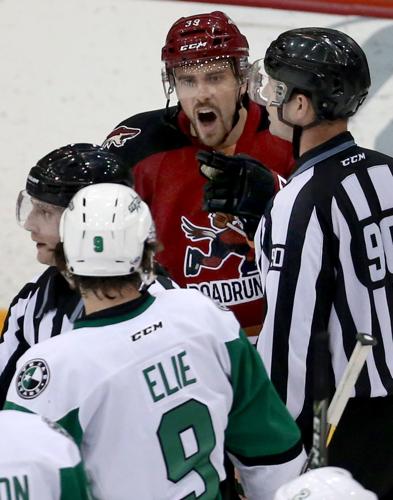On a degree-of-difficulty scale, covering the Tucson Roadrunners turned out to be among the most labored of all assignments I’ve been given in this business.
How tough? Twenty years ago this week, I was five minutes shy of an 11 p.m., deadline when Ortege Jenkins somersaulted into the end zone to beat the Washington Huskies, launching the most memorable season in UA football history.
But re-writing that story, and many others in similar beat-the-clock chaos, was not as challenging as understanding what happens during a Roadrunners hockey game.
No matter how many Roadrunners games I attended, I could not tell the difference between a good player and a bad player. Or if there was any real strategy besides knocking the living H-E-double-hockeysticks out of a guy on the other team.
That’s never true in baseball and basketball. It takes 11 seconds to see that you want Mike Trout on your team.
Covering the Roadrunners reminded me of a long-ago day with the 1978 Tampa Bay Buccaneers, when I wrote that Bucs offensive tackle Darryl Carlton played well and could someday be an All-Pro.
A few days later, Buccaneers coach John McKay pulled me aside and tactfully corrected my assertion that Carlton was bound for the Hall of Fame.
“When we evaluate offensive linemen,” McKay said, “we watch and re-watch each lineman two or three times per play. It takes hours to get a true assessment. We watch every movement. Was he accidentally tripped? Did he just get lucky? Was he playing against someone smaller and slower?”
Carlton, a first-round draft pick in 1975, was out of football a year later.
That’s how I felt trying to write about the Roadrunners during the 2018 Calder Cup playoffs. As much as I fixed my eyes on 6-foot 3-inch, 210-pound Dylan Strome — the No. 3 overall pick of the 2015 NHL draft — I seemed to miss a game-turning play elsewhere on the ice.
What happened? Who did it? I was as close to clueless as you can get.
About all I figured out was that Strome looked imposing in a uniform, and that he didn’t back down from anybody. But in hockey, who does?
This season, which begins Saturday night at the Tucson Arena, I am determined to know the difference between boarding, hooking, cross-checking and high-sticking.
Until then, this is what I know about the Roadrunners as the 2018-19 American Hockey League season begins:
- Everyone is from somewhere else. On Tuesday at the Tucson Arena, first-year head coach Jay Varady said, “Live where your shoes are; it’s like I’ve been in 12 cities in 16 years.”
Varady is the Roadrunners’ third coach in three years. He will coach against AHL legend Roy Sommer of the San Jose Barracuda, 724 career victories, who began in this league in 1998, and has been the head coach of AHL franchises named Thoroughbreds, Sharks, Barons and Barracuda. Similarly, Varady — who is just 41 — has spent the last 15 years coaching in France, Washington, Pennsylvania, Iowa and Ontario, Canada.
Tucson’s training camp roster included 13 Canadians, two players from Sweden, another from Switzerland and even one from Beverly Hills, California. Arizonans? None.
- The AHL is not a league with endless resources. The league realigned over the summer, moving the San Antonio Rampage and Texas Stars from the Pacific Division to the Central Division. It also expanded from 30 to 31 teams, adding the Colorado Eagles to the Pacific Division.
The AHL then made the Eagles the “rival” of the Roadrunners, scheduling 12 games between the two teams. The Roadunners play the other Pacific teams, all in California, just eight times each.
What’s more, the Roadrunners don’t play 19 of the 31 AHL teams.
Pacific Division clubs play just 68 league games; the rest of the AHL plays 76-game schedules. Why? Logistically, it’s a long haul to the wide open spaces of the West and notably expensive for the Roadrunners to travel to the rest of the AHL.
- If you’re looking for someone to hold dear, I suggest left wing Trevor Cheek.
Undrafted in his amateur days, Cheek has reached the so-called Triple-A level of pro hockey by playing for teams named Hitmen, Oil Kings, Monsters, Komets, Rampage and Giants. This is his third year with the Roadrunners, and he has scored 127 minor-league goals.
The AHL scouting analysis of Cheek is that he’s “unafraid” and “lacks fear.” That’ll get you a long way in hockey. His journey is such that the bio from his Twitter feed says “Hockey player living all over the place trying to beat the odds.” Think Crash Davis in “Bull Durham.”
- The Roadrunners and the crazy-busy Tucson Arena appear to have arrived at a schedule that works well for both. There are no long big gaps in the Roadrunners’ home schedule.
Tucson plays four coveted Saturday-Sunday home dates in February, when the Tucson Arena is abuzz. Overall, the Roadrunners have 20 Friday-Saturday home games in a 34-game Tucson schedule.
Some have it worse: San Jose has just 13 Friday-Saturday home games.
Isn’t it strange that the Tucson Arena has never sold naming rights for its sports facilities? Unlike college sports, there’s nothing pure about pro hockey. It’s a for-profit business. Go for it.
Yet the Roadrunners play in a division in which the Colorado Eagles play at the Budweiser Events Center; Bakersfield and Ontario play in arenas named for financial institutions, and the San Diego Gulls play at Valley View Casino Center.
With the Indoor Football League debuting at the Tucson Arena in March, it’s time to commercialize the name of the 47-year-old arena.
The income from naming rights could be used to build the Roadrunners a practice facility, a coveted second sheet of ice in Tucson that could be shared with the fast-growing youth and adult hockey leagues in Tucson.





